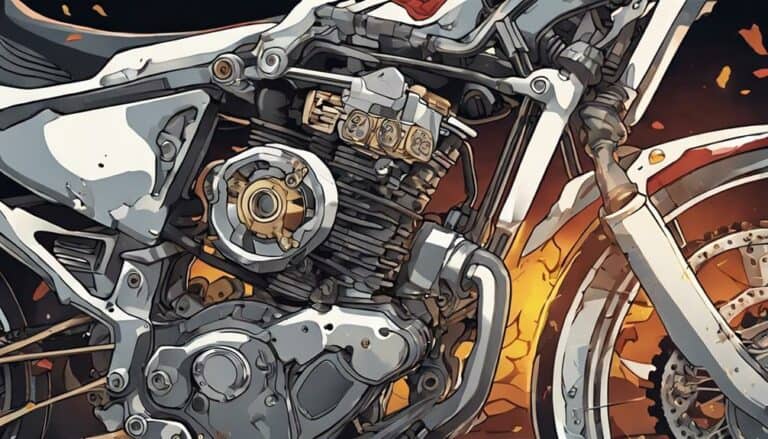Imagine riding through rugged terrain on your dirt bike, feeling the power beneath you as you tackle each obstacle. Have you ever wondered about the mysterious component that helps maintain that seamless flow of energy?
The flywheel on a dirt bike is like a silent hero, silently working its magic to enhance your riding experience. But how exactly does it accomplish this feat?
Let's explore the intriguing world of flywheels on dirt bikes and uncover their secrets.
Key Takeaways
- Flywheel stabilizes power delivery, preventing stalling and enhancing traction.
- Adjusting flywheel weight influences throttle response and overall bike performance.
- Essential for shaping power characteristics and improving control in technical riding situations.
- Proper flywheel weight selection significantly impacts traction, stability, and power delivery.
Importance of Flywheel on Dirt Bikes
The flywheel on dirt bikes plays an essential role in stabilizing power delivery and preventing stalling, particularly in challenging riding conditions. By adding mass to the flywheel, traction and stability at low RPMs are improved, enhancing overall control of the bike. This weight adjustment is important for optimizing performance, allowing riders to tailor their bikes to different terrain preferences and riding conditions. Specific recommendations for flywheel weight sizes are available for various bike models, ensuring riders can fine-tune their machines for peak performance.
Investing in a flywheel weight is highly recommended for woods riding, as it brings noticeable improvements to bike performance and handling. The added weight aids in smoothing out power output, making it easier to manage throttle control and reducing the likelihood of stalling, especially in technical riding situations. Ultimately, the flywheel serves as an important component that contributes to a more controlled and stable riding experience on dirt bikes.
Flywheel Function in Dirt Bike Performance
Enhancing dirt bike performance, the flywheel functions as an important component in stabilizing power delivery and preventing stalling. The moment of inertia of the flywheel plays a vital role in how power is delivered to the wheels. Here's a breakdown of the flywheel's function in dirt bike performance:
- Power Delivery: The weight of the flywheel affects how power is delivered to the wheels, impacting traction and control.
- Throttle Response: Adjusting the flywheel weight can greatly influence throttle response, allowing riders to fine-tune their bike's performance.
- Stability and Control: By enhancing traction and stability at low speeds, the flywheel improves control in technical riding situations, giving riders confidence in challenging terrains.
Understanding the role of the flywheel in power delivery and throttle response is key to optimizing a dirt bike's performance for different riding conditions and preferences.
The Role of Flywheel in Dirt Bike Engines
In considering dirt bike engines, the flywheel serves an essential function in optimizing power delivery and control. The flywheel weight plays an essential role in shaping the power characteristics of a dirt bike engine.
By adjusting the flywheel weight, riders can fine-tune the bike's performance to suit their riding style and preferences. A heavier flywheel can provide more inertia, which helps in smoothing out power delivery, reducing stalling tendencies, and enhancing traction, especially in technical riding situations.
The flywheel weight also affects how quickly the engine responds to throttle inputs and how stable the bike feels at low RPMs. Additionally, the flywheel weight is typically housed within the ignition cover, making it a relatively easy component to access and modify.
Riders often notice a noticeable difference in the bike's handling and performance after adjusting the flywheel weight, demonstrating the significant impact this component has on the overall riding experience.
Impact of Flywheel Weight on Dirt Bikes
Adding mass to the flywheel of a dirt bike alters power delivery characteristics, influencing traction and stability in varying riding conditions. When considering the impact of flywheel weight on a motocross bike, here are some key points to keep in mind:
- Lighter Flywheel: A lighter flywheel enhances throttle response by allowing the engine to rev up and down more quickly, ideal for riders seeking a more responsive feel on the track.
- Traction Improvement: Increasing the flywheel weight improves traction, especially beneficial in challenging terrains like woods riding where maintaining grip is essential.
- Balancing Wheel Spin: Adjusting the flywheel weight can help manage wheel spin, providing riders with better control over acceleration in different scenarios.
Enhancing Dirt Bike Performance With Flywheel Technology
Adjusting the weight of the flywheel on a dirt bike can greatly impact its performance characteristics, particularly regarding traction, stability, and power delivery. By adding a heavier flywheel, you might enhance the bike's ability to keep spinning at low RPMs, reducing the chances of stalling and providing smoother power delivery.
This improvement in performance is especially noticeable in technical riding situations where maintaining momentum is important. On the other hand, a lighter flywheel could offer quicker revving capabilities, allowing for more aggressive power delivery and increased responsiveness.
Choosing the right flywheel weight for your dirt bike can significantly enhance your overall riding experience, whether you're tackling tricky trails or racing on the track. It's essential to take your riding style, terrain preferences, and desired performance outcomes into account when selecting a flywheel weight upgrade to optimize your dirt bike's capabilities.
Properly matching the flywheel weight with your bike and riding conditions can lead to a substantial enhancement in performance and rider control.
Conclusion
To sum up, the flywheel on a dirt bike is like a conductor orchestrating a symphony of power and efficiency. By storing energy and optimizing engine performance, it guarantees smoother rides and enhances overall performance.
Understanding the importance of the flywheel in dirt bike engines is key to maximizing energy efficiency and achieving peak performance on the trails. Ride on with the confidence that your flywheel is working tirelessly to keep you in control.

